As an Amazon Associate I earn from qualifying purchases.
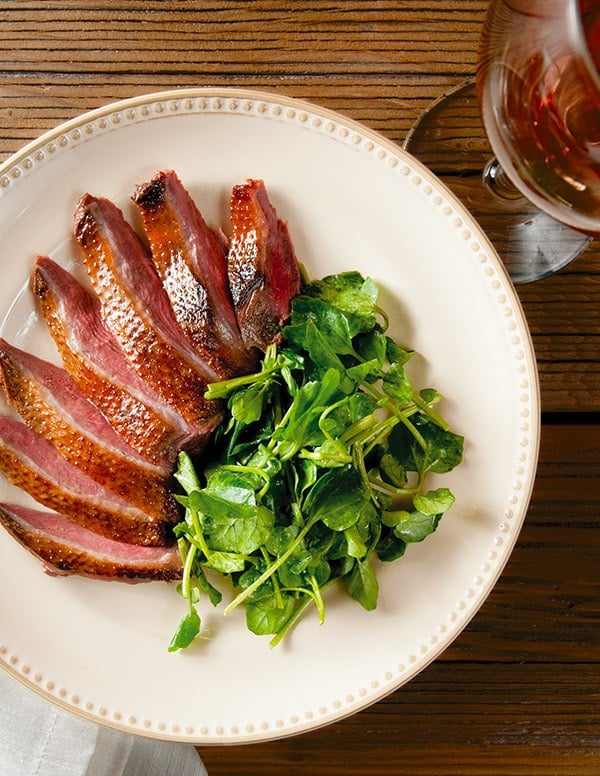
Smoked duck is my favorite way to save our hunting season’s bounty for the warmer months.
Holly and I spend most of our winter days hunting ducks and geese, and we eat them several times a week over the winter months. In that time I do a lot of preserving: Mostly confit, salami, cured goose “prosciutto.” But I will also smoke duck and goose and freeze them for the rest of the year.
Those who know their way around a smoker know that fat is a critical element in the process. Fat absorbs the smoke’s flavor better than the meat itself. This is why you see lots of recipes for smoked pork and salmon; both are fatty animals. So are waterfowl. Domestic ducks and geese are essentially avian pigs, and even wild ducks will have enough fat on them to make it worth some smoke time.
I smoked a flock of ducks and geese to get to this post, so here are my thoughts on what to do, and what to avoid.
For starters, if you are using domestic ducks and geese you will want to remove as much of the fat inside the body cavity and around the neck as you can. Save it, though, and render the duck fat for cooking later.
You will want to prick the skin of a domestic duck or goose all over with a needle — be careful not to pierce the meat, though. This helps rendered fat escape. I’ve even done this on fat wild ducks such as pintail and gadwall that had been gorging themselves on rice.
If you have wild waterfowl, follow these guidelines:
- Don’t smoke sea ducks, divers or shovelers you think might be fishy. Smoking will not help you. Skin these birds and do something else with them.
- Avoid smoking snow geese or any other wild bird that is über-lean; you need some fat to make this work. Even a little is OK.
- Only smoke plucked birds. Remember, the smoky flavor lingers in skin and fat far more than meat. If you smoke a skinned duck it will be more like jerky and less like a proper smoked duck.
- Smoking whole birds give you better results than pieces. Smoking a whole goose or duck will keep the meat more tender and juicy.
- Big ducks smoke better than small ducks, although there is no reason you can’t smoke a teal.
To brine or not to brine? I’ve done both. If you want to eat the smoked duck for a Sunday dinner or whatnot, you can skip the brining — unless your duck is pretty lean, in which case the brine can help the meat stay moist. But brining a duck, especially if you use pink salt, will help preserve the bird longer in the fridge and will let you smoke it longer without drying out the meat.
So, if you choose to brine, do this:
- Mix 1/4 cup kosher salt with 4 cups water and submerge your duck in the fridge overnight.
- If you want to cold-smoke (below 90°F) or smoke for a very long time or if you want that pretty pink color, add 1/2 to 1 teaspoon of pink salt, sodium nitrite, a/k/a Instacure No. 1.
- When your duck is nicely brined, take it out of the water and pat it dry. Set it in a cool, drafty place for a few hours to dry out a bit. If you want to go the extra mile, put a fan on the ducks. After it is dry, then you can smoke it. if you skip this step and put a wet duck in the smoker, the smoke will not adhere as well to the skin or meat of the bird.
If you are skipping the brine, simply pat the duck or goose dry, let it dry out for a few hours and salt it well before smoking.
As for flavors, I am in love with the combination of smoke, duck, salt and maple. And not just any maple: I prefer the thick, super-premium maple syrup from Blis, which you can buy online. If you don’t want to bother with fancy syrup, boil down regular maple syrup by half; it’s close, but not the same. I need no other flavors in my life, but honey would be good, as would a Cajun rub, something vaguely Indian, chiles, French quatre epices, etc. Use your imagination.
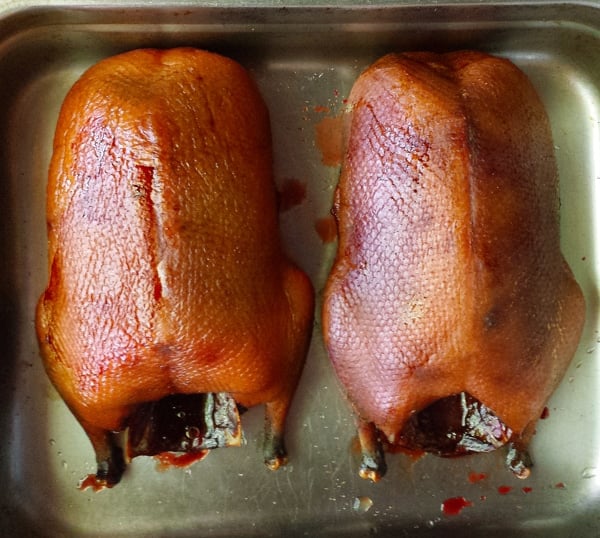
Wood is another choice you will need to make. I am a big fan of fruit or nut woods, like apple, pecan or walnut. Oak is OK, mesquite too weird.
How you place your duck in the smoker doesn’t really matter. I’ve stood them on end like a beer can chicken, with a glass jar jammed up its butt, and it worked well. But I’ve also just set the duck down on the rack, breast side up, and it went fine, too. You will always need a drip pan under the birds, as they will drip fat.
Your final issues are temperature and time.
If you plan on serving the smoked duck for dinner, go with a hotter temperature, between 250 to 275°F. This renders fat pretty well and gets you closer to a crispy skin. As for time, I prefer 2 1/2 to 3 1/2 hours at this temperature.
To crisp the skin, get your grill or oven ripping hot — 500°F or so — and put the ducks in with a drip pan underneath for a few minutes, until the skin crisps. Check after 5 minutes, and in no circumstances let the ducks or geese sit in this temperature more than 15 minutes.
If you want to have a traditional smoked duck, served cold as a luncheon meat or as an appetizer, keep the temperature closer to 200°F, and not hotter than 225°F. This will still render some fat, but will not crisp the skin — duck skin will lose its crispiness anyway once you put the cooled duck in the fridge. As for time, at least 3 hours and up to 6 hours. If you go to the long end of this scale, you will need the pink salt.
Allow the duck to cool before carving. Sliced thin and on the diagonal, smoked duck is fantastic as part of an appetizer plate or in a sandwich. You can also carve a whole breast, sear the skin side in a frying pan until it crisps again, and serve it with lentils or polenta. Again, use your imagination.
And for God’s sake save that carcass! It becomes the base of some of my all-time favorite soups, from smoked duck soup, to classic North Dakota knoephla soup, to a German duck broth with dumplings.
Smoked Duck or Goose
Ingredients
- 1 large duck or small wild goose
- Salt
- 1/4 cup thick maple syrup
Instructions
- Salt the duck well inside the cavity, then paint the outside of the bird with the maple syrup. Salt the outside well.
- Set the bird in your smoker with a drip pan underneath. Smoke between 200 and 225 degrees over apple wood for 4 hours. Baste the ducks with the maple syrup every hour. When smoked, allow to cool completely, then carve. Serve cool or at room temperature as a cold cut or appetizer, or carve the breast whole and sear in a pan. Slice and serve with lentils.
Nutrition
Nutrition information is automatically calculated, so should only be used as an approximation.
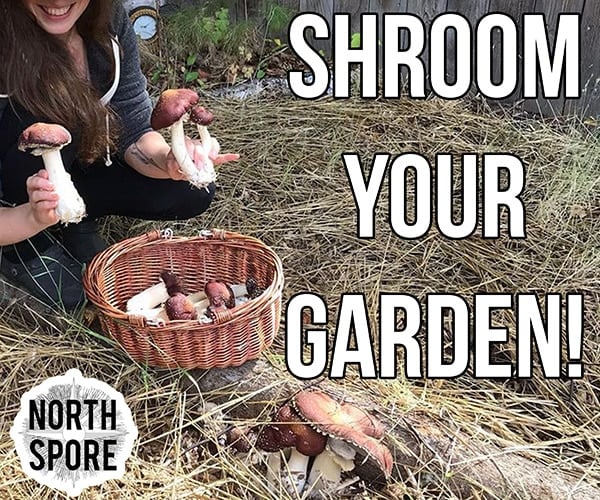

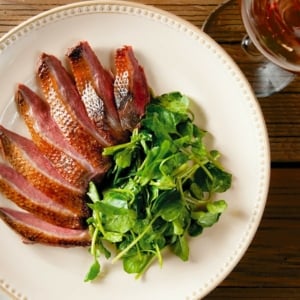

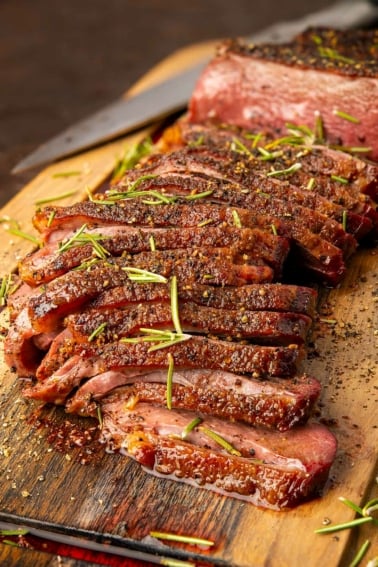
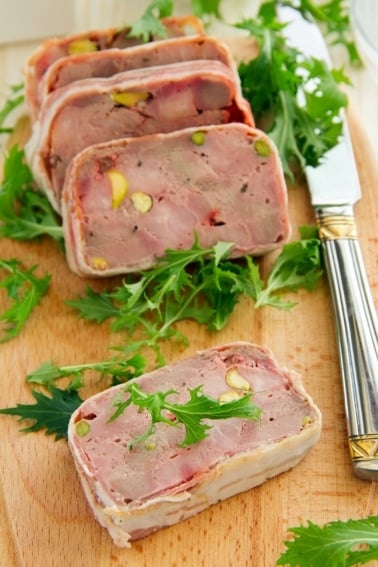

Diana,
What do you make with the broth?
Logan: This soup: https://honest-food.net/2016/02/18/smoked-duck-soup/
Hank – I have used your recipes for duck and goose countless times and it has become my “go to”. I just wanted to pass on a little info on something I tried that was a success regarding the skin and the carcass later on.
I’ve found that if I put just the smoked chicken, duck, or goose skin in an air fryer after smoking it works beautifully! Think chicharones. It won’t be on the whole bird, but the bits of crisped skin can be plated up, or better yet snacked on by the hard working chef before serving.
For the carcass I just make basic bone broth, but then reduce it way down to a Jell-O like thickness. Using a spoonful of that broth concentrate in a recipe makes it something really special.
I used this recipe to make smoked duck for a multi-course dinner centered around Peking-style duck dinner (pancakes, scallions and cucumbers with homemade plum sauce).
I roasted three ducks for three hours at 225′ in my electric smoker – the meat was nicely done, easily shredded and full of smokey goodness. The skin was pretty disappointing but I don’t think that’s really fixable – the drying effect of smoke and the lower roasting temp isn’t going to produce crispy skin, it’s just too leathery. Even running it through the oven at 500′ for a few minutes only gave marginal improvement. Still, Peking duck is a mix of shredded meat and skin and the general smokiness from the skin was great.
I note a lot of people here proposing to use the smoked duck carcass for stock – I don’t think this would work very well. In my experience (mostly around smoked chicken carcasses) the smoke flavor comes through really strongly, rendering the stock too weird to use for anything. That said, I had smoked a few test ducks in advance of the dinner and was going to throw out the carcasses until I happened on Momofuku’s tare recipe, which relied on a chicken back and smokey bacon. Ok… this might work, I thought. Tare is basically Japanese dipping sauce and is sort of a “chef’s secret” with everyone using different variations (feel free to correct me if someone knows more than I do). Momofuku is using it as a flavoring sauce for their ramen in this example. It’s simply a matter of simmering the duck carcass for a while in a mix of mirin, sake and soy sauce.
I served it with my duck ramen soup and my guests went wild for it – the smokiness played well with the savory/salt of the soy and the sweetness of the mirin. In addition to soup, it’s worked as dipping sauce for dumplings and stir fry flavoring. I’m sure it would be great with fish as well. Here’s the original recipe, just substitute duck carcass for roast chicken back and bacon:
https://luckypeach.com/recipes/momofuku-ramen-2-0/
Mark: Trust me. The smoked carcass is wonderful for a soup broth. I use it every time I make a smoked duck. Here is my favorite way to use it: https://honest-food.net/2016/02/18/smoked-duck-soup/ Also, this is nothing remotely like Peking duck, so I am not sure why you used this recipe for that, unless I am misunderstanding your comment. Peking duck isn’t smoked, incidentally.
Wow. I am bookmarking this page. Thank you SO much for all the helpful info! I am so impressed! Just got a Bradley Smoker & have been smoking trout & salmon like crazy, but tomorrow I will try this and smoke some of my wild black ducks for a Supper Club I’m having here in Nova Scotia. Thanks again!! 🙂
I know this post is from about three years ago, but hopefully you still reply to questions. Full disclosure: I’m brand new to smoking, I have no idea what I’m doing. Also, I have very little prior experience with eating duck so I’m not sure what a “good” duck is supposed to taste like. I just got this electric smoker for Father’s Day and I’ve been smoking stuff like a madman ever since.
With all that said. We’re doing a small Christmas eve dinner and I had the bright idea to smoke a duck for it. My wife found this post and we decided to do a dry run. I got a frozen Muscovy duck thawed it out and followed your recipe. Did not brine. Salted the inside, painted with maple syrup and basted with maple syrup every hour. I put it in at 225 for ~4 hours. I let the internal temp. get up to 160 and pulled it out.
The meat was really tasty but pretty tough and a little dry. Is this normal? If not, what did I do wrong? After skimming through the comments it looks like the internal temp. of duck doesn’t need to reach 165. Should I really pull it out at 150? My in-laws would never forgive me if I gave them salmonella for Christmas.
That’s all I got. Thanks in advance for any help you can offer.
Michael: Brine it. It is important. And use the curing salt, as it will keep everything pretty and pink. You won’t give anyone salmonella, incidentally. Ducks aren’t normally a carrier of it. And keep in mind that the legs and wings will be a little tough. I generally use them in stews after I’ve smoked the duck. The prize is the breast meat.
For those asking about how much pink salt (instacure #1) to use, the standard ratio is measured by weight. Weigh the combined meat (the duck) and the brine liquid, then add pink salt in the amount of 0.25% (one quarter of one percent) of the total weight. For example if you have one gallon of brine liquid (weight 128 oz) and a duck which weighs 2 lbs (36 oz) then your total weight is 164 oz. One quarter of one percent of that is .41 oz of pink salt.
A digital kitchen scale is not too expensive and is a very helpful addition to your kitchen especially when you are reading charcuterie recipes which are often expressed by weights and percentages of weights.
If you go a lot under .25% then your pink salt won’t be effective, if you go way over then you are eating more nitrites than you need to.
The pink salt is in addition to the regular (kosher or sea) salt which you use to create your brine mix.
Hank, would you change the process at all when smoking ducks for a duck and andouille gumbo?
Jason: Nope. I’d do it as is.
You should be writing books. I’ve never seen anyone wrap so many variables into a workable recipe. There’s a brined farm duck hanging over my sink in front of a fan right now, and a stack of oak and cherry out by my Bar-B-Chef. BUT, if I’m to go the ‘long-term’ 5-6 hour route, would you recommend tenting it in foil before I go for the big heat at the end?
Neil: Um… I do write books. In fact, I wrote a book about cooking ducks (link is at the top of your screen). To answer your question, yes, tent it.
how long to smoke a 6 lb duck in digital smoker @ 200 f.?
Rian: Until it’s done. Sorry, but there is no set time because it all depends on how fat the duck is, what your outside temperature is, how fast your smoker gets hot, etc. Best guess? About 4 hours. Use a thermometer to check doneness.
Hank,
Absolutely love the site. Question on timing for smoking: if I’m going for a long smoke on a duck, and want to use your grill method after the smoke session to crisp the skin, do you know if there’s any reason I couldn’t wait, say, 30 minutes or an hour between the time I finish smoking and the time I put the bird on the grill?
(Context: I and a group of buddies consistently try to outdo ourselves at sporting event tailgating sessions, and I tend to think that smoked duck would have to be at or near the pinnacle of tailgating cuisine.)
Best,
Aaron
Any tips for keeping skinned goose beats moist during the smoking process? After a brine what temperature does the meat need to rise to in order to be safe to eat?
Tyler: Smoking skinless breasts is tricky. The brine is your only insurance policy…
Hank,
I have used your smoked duck recipe several times with great success on my offset charcoal/wood smoker – my only variation has been to start with 50/50 cane syrup and bourbon and reduce that by 1/2. Otherwise, I have followed your recipe to the letter, using mallards and wood ducks, though with a shorter smoke time for the wood ducks.
Things changed when I got an electric smoker for Christmas, and I am hoping you might have a suggestion. In the offset smoker, the ducks have come out beautifully – deep golden mahogany. I have smoked some mallards and pintails on the electric smoker, and the ducks have come out a muddy brown. The temperature is the same in both units, per my digital thermometer, but the results in the electric smoker have been very different. The taste is okay, but the color is less than appetizing. The only thought I have is that the cover on the offset smoker may be radiating/reflecting heat onto the skin of the birds, causing the skin to brown and the sugar in the syrup to caramelize. However, that is just a guess. I am not really sure what the difference is. If you have any suggestions, they would be welcome. It would be nice to be able to use the electric smoker, as it is much more convenient than the offset smoker, but I don’t want to sacrifice any more of the ducks in my freezer to random experimentation.
Thanks for any help you can provide and keep up the great work on this great site.
Ronald
Hank – thanks for the response. I can’t wait to try the lower cold cut recipe later on. As for the dinner temp, both birds are relaxing in an electric aromatherapy sauna as I type so I’m looking forward to trying them.
Thanks for getting back to me so quickly! My family is having a good “We told you so” laugh about what you said about the coot. I happen to like coot, and have found that using your maple smoking technique gets rid of lots of their legendary “muddy” flavor. Perhaps my fondness for them is related to my lousy shooting and their awkward, easier to hit flying… Also, I have used this recipe a few times now on shitake mushrooms; they smoke up nice! Do you reckon it’s worth trying on a few fresh bolete caps, to be eaten as appetizers?
LOL. Yeah, I eat coots, but I skin then first. Mostly for gumbo. As for the porcini caps, absolutely! Sounds like it’d be good.
Hi Hank: First of all, I love your website! I wanted to ask, I am smoking a coot, a teal, an Aleutian, a mallard and a turkey for tomorrow over oak and pear wood in my (non-pc) “little chief” charcoal smoker. I am doing it today so I can make your bourbon-maple gravy (with lots of porcinis I picked yesterday) and help with all the other kitchen craziness my family will be up to, tomorrow. I was going to reheat and crisp the skin of the birds tomorrow, but should I worry about them drying out while reheating? What would you do?
Um… you’re smoking a coot? I wouldn’t. It will be like a smoked bottom of a pond. On the rest, you should be OK just crisping the skin afterwards. You might want to even deep-fry the teal. That crisps them up nicely!
For Thanksgiving tomorrow I’ll be smoking both a duck and a turkey (putting the duck on the upper rack to baste the turkey). I didn’t see any notes here on finished temperature? Would I be correct in assuming 180 for the ‘dinner duck’ and about 160 for the ‘cold duck’? I’ll be doing the dinner version tomorrow, but would be interested in the cold version for later on.
Diana: I’d go a little lower on the “dinner” duck, to about 175 degrees, tops, and 170 isn’t too bad.
I had doubts about the recipe. Boy was I wrong! Simple and delicious.
I used mostly cherry wood and a couple of chunks of walnut. Reducing the maple is a must. I didn’t brine, but I sprinkled a little salt with each maple syrup application. Great recipe thanks. Oh, did I mention, great recipe?
Someone ask about smoking a turkey. I have smoked several. Yes I do brine my turkey with 1/2 cup kosher salt, 1/2 cup brown sugar, a large handful of fresh tyme, a 6 inch sprig of rosemary, 1 teaspoon of peppercorns, 1 tablespoon dry mustard. I put all these in a pot of water and bring to a boil. I let the water cool with ice and make sure it is cool before pouring over my turkey. I set the brined turkey in the fridge for at least 24 hours. I then rinse off and pat dry. Rub with butter and apply your favored rub. Let let again for at least a full day wrapped tight in plastic wrap. Now get the smoker ready. I use an electric smoker. I like oak and pecan wood mixed. I smoke at 200 degrees for 12 hours. I have never had any one not want seconds.
Hank: I am intending to smoke duck breast in few days time. This dish will be used with a salad. Should I pan sear the skin before or after the smoking process?
Hank: I shot some ducks in ND which were breasted. Is there a more abbreviated proces without the whole carcass ?